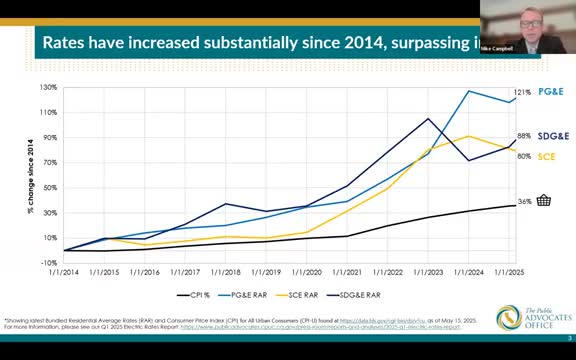California Utilities Examine Strategies to Address Rising Electric Rates and Operating Costs
July 26, 2025 | Little Hoover Commission, Other State Agencies, Executive, California
This article was created by AI summarizing key points discussed. AI makes mistakes, so for full details and context, please refer to the video of the full meeting. Please report any errors so we can fix them. Report an error »

California's electricity costs are surging, outpacing inflation and raising alarms among regulators and consumers alike. During a recent Little Hoover Commission meeting, experts highlighted the urgent need for reform in how electric utilities manage their expenses and investments, which are driving up rates for residents.
The discussion revealed that operating expenses for utilities, particularly in areas like vegetation management and customer service, are growing faster than inflation. Experts argue that these costs could be trimmed without compromising safety or reliability, potentially leading to immediate savings for ratepayers. "Cutting those unreasonably large operating and maintenance expenses could result in immediate and tangible savings," one speaker noted.
Capital costs also emerged as a significant factor in rising electricity rates. The meeting underscored the importance of scrutinizing capital investments to ensure they are necessary and executed at the lowest possible cost. With California's return on equity among the highest in the nation, even slight adjustments in financing can significantly impact customer bills.
Moreover, the meeting addressed the need to shift some costs off utility bills. Experts suggested that certain programs, while socially valuable, should be funded through taxpayer dollars rather than ratepayer bills. This change could save over $500 million annually for consumers.
Finally, the commission discussed the necessity of updating rate designs to reflect modern energy consumption patterns. As more customers adopt solar energy and other alternatives, traditional rate structures are becoming outdated, leading to increased costs for those who remain on the grid.
The implications of these discussions are profound. With California facing a rates crisis, the commission's recommendations could pave the way for more equitable and sustainable electricity pricing, ultimately benefiting consumers across the state. As the California Public Utilities Commission (CPUC) continues to explore these issues, stakeholders are hopeful for a future where electricity costs are more manageable and transparent.
The discussion revealed that operating expenses for utilities, particularly in areas like vegetation management and customer service, are growing faster than inflation. Experts argue that these costs could be trimmed without compromising safety or reliability, potentially leading to immediate savings for ratepayers. "Cutting those unreasonably large operating and maintenance expenses could result in immediate and tangible savings," one speaker noted.
Capital costs also emerged as a significant factor in rising electricity rates. The meeting underscored the importance of scrutinizing capital investments to ensure they are necessary and executed at the lowest possible cost. With California's return on equity among the highest in the nation, even slight adjustments in financing can significantly impact customer bills.
Moreover, the meeting addressed the need to shift some costs off utility bills. Experts suggested that certain programs, while socially valuable, should be funded through taxpayer dollars rather than ratepayer bills. This change could save over $500 million annually for consumers.
Finally, the commission discussed the necessity of updating rate designs to reflect modern energy consumption patterns. As more customers adopt solar energy and other alternatives, traditional rate structures are becoming outdated, leading to increased costs for those who remain on the grid.
The implications of these discussions are profound. With California facing a rates crisis, the commission's recommendations could pave the way for more equitable and sustainable electricity pricing, ultimately benefiting consumers across the state. As the California Public Utilities Commission (CPUC) continues to explore these issues, stakeholders are hopeful for a future where electricity costs are more manageable and transparent.
View full meeting
This article is based on a recent meeting—watch the full video and explore the complete transcript for deeper insights into the discussion.
View full meeting
